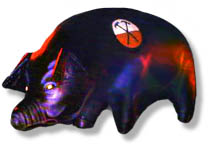|
Home, Piggy, home! Was the appearance of the pig during performances of The Wall a nostalgic nod to the Floyd of the 70s, or did it mean more? By Rick Karhu The pig is an interesting symbol to say the least. Not only is it the most conspicuous symbol with which Pink Floyd is associated, but it is curious as to how the pig was recycled for performances of The Wall in 1980-1. Obviously, the most cynical fan would draw the conclusion that the flying pig had become a standard part of the Pink Floyd live show of the mid-70s and that pulling off the performance of The Wall without an appearance of the famous porcine inflatable would disappoint the audience.
However, it's hard to believe that anyone seeing the performance of The Wall in the early 80s would be disappointed by much of anything; likewise, there is little support for the notion that Pink Floyd clung to any one prop or concept for too long. Even the most casual survey of their shows throughout the late 60s and the 70s reveals how quickly ideas and concepts were explored, brought to fruition, and discarded. Was it just simple nostalgia? Run Like Hell Piggy So why did the pig make an appearance at the performance of The Wall? It's curious that The Wall was so strongly conceived as a statement against arena rock and yet just before "Run Like Hell" one of the most notorious symbols of 70s arena rock makes its unlikely appearance. You could say that Roger perhaps wanted to invoke the spirit of those abominably large and inhuman arena rock shows that he detested so much. It would make sense. The Wall is all about theater and it's a very theatrical move to invoke that warm and wonderful spirit of arena rock only to follow it up with some horrible rant against the audience and the pig. It's Roger's performance art at its best. For instance, the audience treated to the spectacle of The Wall live in Los Angeles, February 13, 1980, were treated to this lovely rant from Roger as the pig made its appearance: "Thank you. You like our pig? He's not a very good pig, but he's a BIG pig. We're gonna play a tune for you now that I'd like to dedicate to all the paranoids in the audience, of which I'm sure there are many. Let's hear it for all the paranoids. Called 'Run Like Fuck.' Home piggy, home!" Not exactly the warm embrace the audience might expect at that moment. So perhaps there is some weight to the idea that Roger was setting the audience up only to deliver a nasty sucker punch. That's an idea that occurs in other places in the performance of The Wall; it's not entirely impossible that this was just another variation on that theme.
Keep our feelings off the street When the pig made its auspicious debut as the undisputed symbol with which Pink Floyd would be associated, it was a symbol of the powerful and greedy folks that the Animals album was attacking: the avaricious, the cold-hearted, the officious, the selfish, those who would try to control others. These people were not entirely abstractions either as anyone listening to Animals will note that one target is actually listed by name. However, in general, it appears that Roger's vicious lyrical assault on Animals is aimed primarily at corporate executives, businessmen, politicians, religious leaders and the like. On Animals, the pig is a symbol of external forces, those people out there who would have us keep our feelings off the street or those who would force us to keep one eye looking over our shoulder. At the performances of The Wall, however, it's clear that the pig represents Roger (or at least Roger of the mid-70s.) Roger is on record more than once that The Wall was born from his frustration with the corporate avarice and selfishness that had settled in on the post-Dark Side Pink Floyd. The pig's appearance is a chance for Roger to repudiate both symbolically and publicly the side of him that would be at home with the other pigs that populate the lyrics of Animals. So, in contrast to its counterpart on Animals, the pig of The Wall is a symbol of internal forces. And while it certainly is an apt metaphor for the ugly turn of events concerning the fictitious Pink whose life is examined in The Wall, it's also an equally apt metaphor for the creator of The Wall and his reaction against what he saw himself becoming. One rarely sees an artist turn his own metaphor on himself, but Roger did it with the sort of stunning ease that only he can pull off. And done as it was in the context of The Wall, it only serves to make its point more powerfully and poignantly.
|

 However,
I think there may be a better reason, a deeper reason that Roger chose
to trot out the inflatable pig at that moment and it had more to do
with himself than the audience.
However,
I think there may be a better reason, a deeper reason that Roger chose
to trot out the inflatable pig at that moment and it had more to do
with himself than the audience.